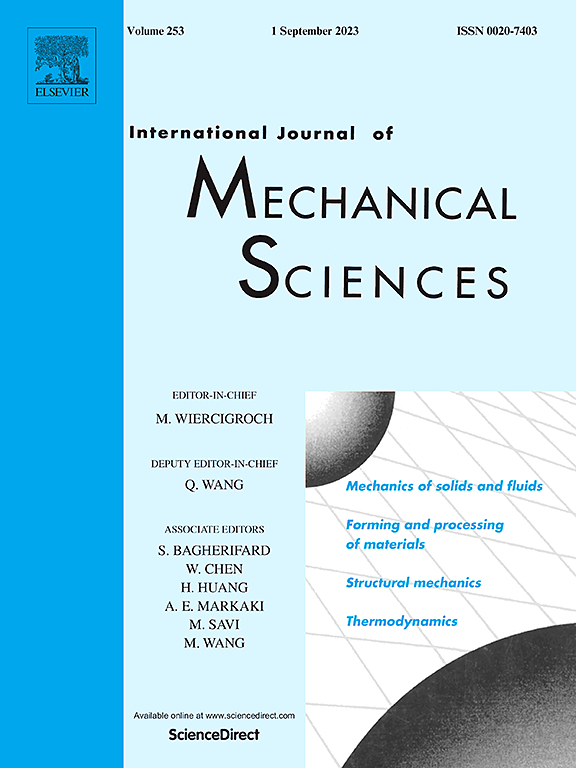Snap-through behaviors of bistable composite panel in centrifugal environments
IF 7.1
1区 工程技术
Q1 ENGINEERING, MECHANICAL
International Journal of Mechanical Sciences
Pub Date : 2025-02-02
DOI:10.1016/j.ijmecsci.2025.110036
引用次数: 0
Abstract
In this paper, a cross-well dynamics model of bistable composite panels in centrifugal environments is proposed. The external excitation applied at the four corners is assumed to be a uniformly distributed harmonic acceleration. Nonlinear equations are derived by combining geometric nonlinearity, thermal stresses, and centrifugal effects with the first-order shear deformation theory, and are expressed in terms of curvature. Additionally, the maximum Lyapunov exponent is used to classify vibration types. Observations of periodic and chaotic snap-throughs are categorized into vibration type domains. To facilitate understanding, bifurcation diagrams, phase portraits, time histories, and Poincaré maps are presented for representative operating conditions. The effects of centrifugal environments, external excitation amplitude, and frequency on snap-through behavior are thoroughly investigated. The results show that there exists a critical static angular velocity, beyond which the panel cannot maintain bistability, and indicate that snap-through behavior in bistable panels is caused by negative stiffness due to residual thermal stresses. Bistable composite panels exhibit both forward and backward bouncing. Furthermore, three types of frequencies are identified: upper Stable I frequency, lower Stable II frequency, and snap-through frequency. It is also noted that the impact of angular velocity on these frequencies is not uniform. When the external excitation frequency approaches one stable state frequency, it can destabilize the configuration, causing vibrations to occur in the other configuration.

求助全文
约1分钟内获得全文
求助全文
来源期刊

International Journal of Mechanical Sciences
工程技术-工程:机械
CiteScore
12.80
自引率
17.80%
发文量
769
审稿时长
19 days
期刊介绍:
The International Journal of Mechanical Sciences (IJMS) serves as a global platform for the publication and dissemination of original research that contributes to a deeper scientific understanding of the fundamental disciplines within mechanical, civil, and material engineering.
The primary focus of IJMS is to showcase innovative and ground-breaking work that utilizes analytical and computational modeling techniques, such as Finite Element Method (FEM), Boundary Element Method (BEM), and mesh-free methods, among others. These modeling methods are applied to diverse fields including rigid-body mechanics (e.g., dynamics, vibration, stability), structural mechanics, metal forming, advanced materials (e.g., metals, composites, cellular, smart) behavior and applications, impact mechanics, strain localization, and other nonlinear effects (e.g., large deflections, plasticity, fracture).
Additionally, IJMS covers the realms of fluid mechanics (both external and internal flows), tribology, thermodynamics, and materials processing. These subjects collectively form the core of the journal's content.
In summary, IJMS provides a prestigious platform for researchers to present their original contributions, shedding light on analytical and computational modeling methods in various areas of mechanical engineering, as well as exploring the behavior and application of advanced materials, fluid mechanics, thermodynamics, and materials processing.
 求助内容:
求助内容: 应助结果提醒方式:
应助结果提醒方式:


